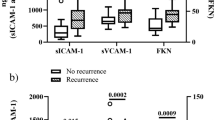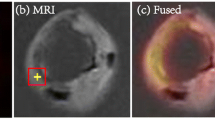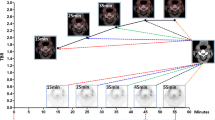Abstract
Introduction
The vulnerable atherosclerotic lesion exhibits the proliferation of neovessels and inflammation. The imaging modality 2-deoxy-2-[18F]fluoro-d-glucose positron emission tomography (18FDG-PET) is considered for the identification of vulnerable plaques.
Purpose
The purpose of this study was to compare the gene expression of neoangiogenesis and vulnerability-associated genes with 18FDG uptake in patients undergoing carotid endarterectomy.
Procedures
Human atherosclerotic carotid artery plaques from symptomatic patients were used for gene expression analysis by quantitative PCR of vascular endothelial growth factor (VEGF) and integrin αV and integrin β3 subunits, genes essential during neoangiogenesis. We also evaluated the gene expression of CD34, a measure of microvessel density (MVD), as well as CD68, MMP-9, and cathepsin K, genes of major importance in plaque vulnerability. Gene expression analysis was compared with 18FDG-PET.
Results
VEGF and integrin αVβ3 gene expression did not correlate with 18FDG uptake, whereas CD34 gene expression exhibited an inverse correlation with 18FDG uptake. Additionally, we established that markers of vulnerability were correlated with 18FDG uptake.
Conclusions
Neoangiogenesis is not associated with 18FDG uptake, whereas MVD and markers of vulnerability correlate with 18FDG uptake. The absence of correlation between markers of neoangiogenesis and 18FDG uptake suggests a temporal separation between the process of neoangiogenesis and inflammatory activity.



Similar content being viewed by others
References
de Boer OJ, van der Wal AC, Teeling P et al (1999) Leucocyte recruitment in rupture prone regions of lipid-rich plaques: a prominent role for neovascularization? Cardiovasc Res 41:443–449
Jeziorska M, Woolley DE (1999) Local neovascularization and cellular composition within vulnerable regions of atherosclerotic plaques of human carotid arteries. J Pathol 188:189–196
Risau W (1997) Mechanisms of angiogenesis. Nature 386:671–674
Kumamoto M, Nakashima Y, Sueishi K (1995) Intimal neovascularization in human coronary atherosclerosis: its origin and pathophysiological significance. Hum Pathol 26:450–456
Galis ZS, Lessner SM (2009) Will the real plaque vasculature please stand up?Why we need to distinguish the vasa plaquorum from the vasa vasorum. Trends Cardiovasc Med 19:87–94
Pedersen SF, Graebe M, Fisker Hag AM et al (2010) Gene expression and 18FDG uptake in atherosclerotic carotid plaques. Nucl Med Commun 31:423–429
Carmeliet P, Ferreira V, Breier G et al (1996) Abnormal blood vessel development and lethality in embryos lacking a single VEGF allele. Nature 380:435–439
Ferrara N, Carver-Moore K, Chen H et al (1996) Heterozygous embryonic lethality induced by targeted inactivation of the VEGF gene. Nature 380:439–442
Bjornheden T, Levin M, Evaldsson M et al (1999) Evidence of hypoxic areas within the arterial wall in vivo. Arterioscler Thromb Vasc Biol 19:870–876
Shweiki D, Itin A, Soffer D et al (1992) Vascular endothelial growth factor induced by hypoxia may mediate hypoxia-initiated angiogenesis. Nature 359:843–845
Celletti FL, Waugh JM, Amabile PG et al (2001) Vascular endothelial growth factor enhances atherosclerotic plaque progression. Nat Med 7:425–429
Ramos MA, Kuzuya M, Esaki T et al (1998) Induction of macrophage VEGF in response to oxidized LDL and VEGF accumulation in human atherosclerotic lesions. Arterioscler Thromb Vasc Biol 18:1188–1196
Brooks PC, Clark RA, Cheresh DA (1994) Requirement of vascular integrin alpha v beta 3 for angiogenesis. Science 264:569–571
Hoshiga M, Alpers CE, Smith LL et al (1995) Alpha-v beta-3 integrin expression in normal and atherosclerotic artery. Circ Res 77:1129–1135
Fina L, Molgaard HV, Robertson D et al (1990) Expression of the CD34 gene in vascular endothelial cells. Blood 75:2417–2426
Asahara T, Murohara T, Sullivan A et al (1997) Isolation of putative progenitor endothelial cells for angiogenesis. Science 275:964–967
Uzzan B, Nicolas P, Cucherat M et al (2004) Microvessel density as a prognostic factor in women with breast cancer: a systematic review of the literature and meta-analysis. Cancer Res 64:2941–2955
Tawakol A, Migrino RQ, Bashian GG et al (2006) In vivo 18F-fluorodeoxyglucose positron emission tomography imaging provides a noninvasive measure of carotid plaque inflammation in patients. J Am Coll Cardiol 48:1818–1824
Rudd JH, Warburton EA, Fryer TD et al (2002) Imaging atherosclerotic plaque inflammation with [18F]-fluorodeoxyglucose positron emission tomography. Circulation 105:2708–2711
Andersen CL, Jensen JL, Orntoft TF (2004) Normalization of real-time quantitative reverse transcription-PCR data: a model-based variance estimation approach to identify genes suited for normalization, applied to bladder and colon cancer data sets. Cancer Res 64:5245–5250
Livak KJ, Schmittgen TD (2001) Analysis of relative gene expression data using real-time quantitative PCR and the 2(−Delta Delta C(T)) method. Methods 25:402–408
Airley RE, Mobasheri A (2007) Hypoxic regulation of glucose transport, anaerobic metabolism and angiogenesis in cancer: novel pathways and targets for anticancer therapeutics. Chemotherapy 53:233–256
Fang HY, Hughes R, Murdoch C et al (2009) Hypoxia-inducible factors 1 and 2 are important transcriptional effectors in primary macrophages experiencing hypoxia. Blood 114:844–859
Graebe M, Borgwardt L, Hojgaard L et al (2010) When to image carotid plaque inflammation with FDG PET/CT. Nucl Med Commun 31:773–779
Nizet V, Johnson RS (2009) Interdependence of hypoxic and innate immune responses. Nat Rev Immunol 9:609–617
Vink A, Schoneveld AH, Lamers D et al (2007) HIF-1 alpha expression is associated with an atheromatous inflammatory plaque phenotype and upregulated in activated macrophages. Atherosclerosis 195:e69–e75
Carmeliet P (2003) Angiogenesis in health and disease. Nat Med 9:653–660
Hellwig-Burgel T, Rutkowski K, Metzen E et al (1999) Interleukin-1beta and tumor necrosis factor-alpha stimulate DNA binding of hypoxia-inducible factor-1. Blood 94:1561–1567
Jung YJ, Isaacs JS, Lee S et al (2003) IL-1beta-mediated up-regulation of HIF-1alpha via an NFkappaB/COX-2 pathway identifies HIF-1 as a critical link between inflammation and oncogenesis. FASEB J 17:2115–2117
Stubbs M, Griffiths JR (2010) The altered metabolism of tumors: HIF-1 and its role in the Warburg effect. Adv Enzyme Regul 50:44–55
Haubner R, Wester HJ, Weber WA et al (2001) Noninvasive imaging of alpha(v)beta3 integrin expression using 18F-labeled RGD-containing glycopeptide and positron emission tomography. Cancer Res 61:1781–1785
Laitinen I, Saraste A, Weidl E et al (2009) Evaluation of alphavbeta3 integrin-targeted positron emission tomography tracer 18F-galacto-RGD for imaging of vascular inflammation in atherosclerotic mice. Circ Cardiovasc Imaging 2:331–338
Antonov AS, Kolodgie FD, Munn DH et al (2004) Regulation of macrophage foam cell formation by alphaVbeta3 integrin: potential role in human atherosclerosis. Am J Pathol 165:247–258
Senger DR, Ledbetter SR, Claffey KP et al (1996) Stimulation of endothelial cell migration by vascular permeability factor/vascular endothelial growth factor through cooperative mechanisms involving the alphavbeta3 integrin, osteopontin, and thrombin. Am J Pathol 149:293–305
Acknowledgments
The financial support from The Danish Heart Foundation, The Research Fund of Rigshospitalet, The Danish Medical Research Council, The John and Birthe Meyer Foundation, General-consul Friedrich Bøhm and daughter Else Bøhms Foundation, Tove and Richard Severin Hansens Grant, The Oticon Foundation, and finally The Refuge of Løgumkloster is gratefully acknowledged. The PET/CT scanner was donated by the John and Birthe Meyer Foundation. The authors wish to thank Jytte Oxbøl for providing qPCR designs for the measurement of markers of neoangiogenesis as well as all medical laboratory technologists involved in helping out with the PET/CT scans.
Conflict of Interest
The authors declare that they have no conflict of interest.
Author information
Authors and Affiliations
Corresponding author
Rights and permissions
About this article
Cite this article
Pedersen, S.F., Graebe, M., Hag, A.M.F. et al. Microvessel Density But Not Neoangiogenesis Is Associated with 18F-FDG Uptake in Human Atherosclerotic Carotid Plaques. Mol Imaging Biol 14, 384–392 (2012). https://doi.org/10.1007/s11307-011-0507-1
Published:
Issue Date:
DOI: https://doi.org/10.1007/s11307-011-0507-1




